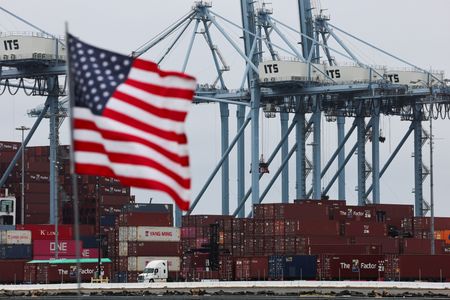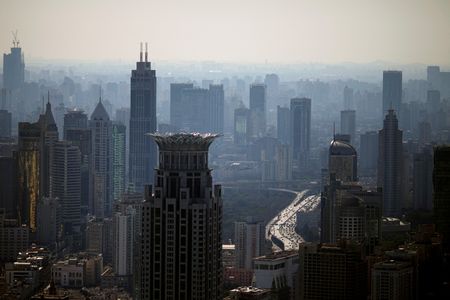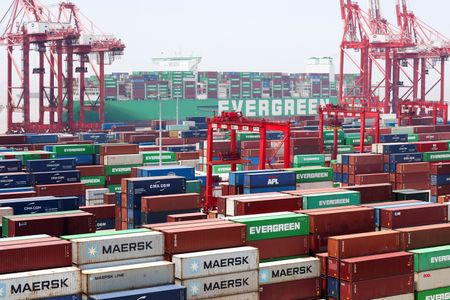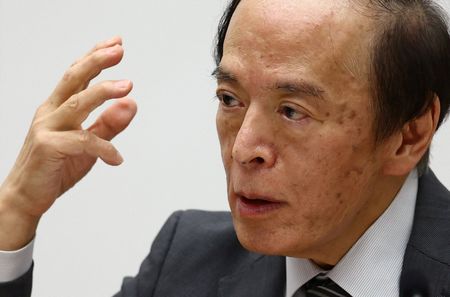By Kevin Yao and Ellen Zhang
BEIJING (Reuters) -Chinese banks extended 2.24 trillion yuan ($312 billion) in new loans in June, more than triple May’s total, and beating analysts’ forecasts, helped by stimulus measures and a trade truce with the United States.
Analysts polled by Reuters had predicted new yuan loans would reach 1.8 trillion yuan in June after 620 billion yuan in May. In the event, it also surpassed last June’s 2.13 trillion yuan.
The People’s Bank of China does not provide monthly breakdowns, but Reuters calculated the June figure by comparing January-June data with the January-May figure.
Annual growth of outstanding total social financing (TSF), a broad measure of credit and liquidity in the economy, rose to 8.9% last month, its highest since February 2024, from 8.7% in May.
“The acceleration in broad credit growth last month, to a 16-month high, is a positive sign for the outlook and reduces the risk of a sharp deceleration in near-term economic activity,” Julian Evans-Pritchard, head of China economics at Capital Economics, said in a note.
“But this tailwind looks set to fade over the rest of the year as government bond issuance, the main driver of the pick-up, starts to slow again.”
New yuan loans totalled 12.92 trillion yuan for the first half of the year, the PBOC data showed, down from 13.27 trillion yuan in the same period last year.
Household loans rose significantly to 597.6 billion yuan in June from 54 billion yuan in May, according to Reuters calculations. Corporate loans rose to 1.77 trillion yuan from 530 billion yuan in May.
A prolonged property slump in the world’s second-largest economy and heightened job insecurity have contributed to borrowers’ hesitance to take on more debt, despite government efforts to promote domestic consumption and stimulate the economy.
BROAD PBOC STIMULUS MEASURES
The central bank unveiled a raft of stimulus measures in May to counter the impact of U.S. tariffs and gained some relief after striking a 90-day trade truce with Washington, followed by a framework agreement signed in London in June.
PBOC deputy governor Zou Lan, speaking at a news conference on Monday, pledged to maintain an “appropriately loose” monetary policy, with adjustments to its pace and intensity as needed to support domestic demand and help achieve the annual economic growth target.
Zou also said China did not seek to gain international competitive advantage through yuan depreciation.
However, concerns about weak domestic demand and factory deflation continue to put pressure on policymakers to add extra stimulus in the wake of renewed trade uncertainty as the U.S. escalates its trade war with a new round of tariffs.
Analysts said further monetary easing was likely to happen very gradually, held back by worries that faster credit growth would exacerbate rather than alleviate industrial overcapacity.
Monday’s data also showed June outstanding yuan loans were up 7.1% from a year earlier, the same pace as in May, which was a record low. Analysts had expected 7.0% growth.
Annual growth in broad M2 money supply sped up to 8.3% in June, the fastest since March 2024, above the 8.1% forecast in the Reuters poll. It had been 7.9% in May.
The narrower M1 money supply was up 4.6% from a year earlier, compared with 2.3% in May.
China is set to release second-quarter GDP data on Tuesday. Growth is expected to have slowed because of the trade tensions, reinforcing expectations of further stimulus.
($1 = 7.1688 Chinese yuan renminbi)
(Reporting by Kevin Yao, Shi Bu, Ellen Zhang;Editing by Shri Navaratnam and Kevin Liffey)








